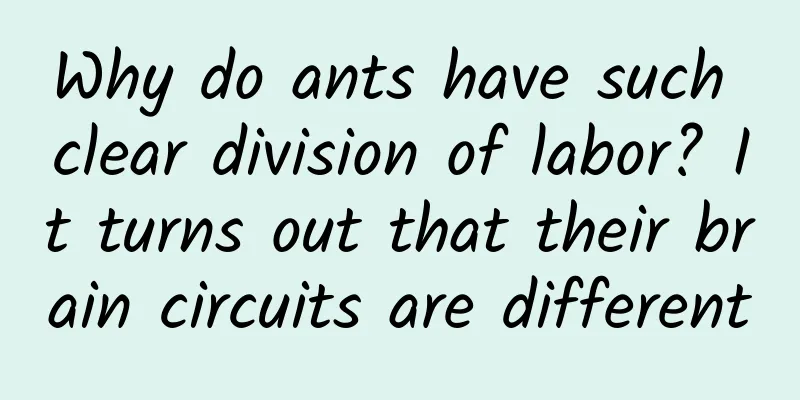Why do ants have such clear division of labor? It turns out that their brain circuits are different

|
In the evolution of animals, a major turning point was the emergence of social organizations, which greatly enhanced the adaptability of animals. Today, we can still find a series of continuous changes in social organization from simple to complex in different species. By analyzing the composition characteristics of brain cell groups in social insects represented by ants, a research team of Chinese and foreign scientists revealed the brain specialization phenomenon that accompanies the social division of labor in social insects, and constructed a single-cell transcriptome map of the brain covering all the division of labor roles in ant society. The above research results were published in the journal Nature Ecology & Evolution on June 16. Ants cannot survive alone Unlike human society, social insects show morphological and physiological differentiation during their development, and ants are a typical example. Ants originated in the Cretaceous period 140 million years ago. There are about 20,000 species today. They are widely distributed in all terrestrial ecosystems except the polar ice sheets and are one of the most successful animal groups in the history of biological evolution. As the most prosperous social insect group on land, the total weight of ants is roughly equivalent to that of all humans on Earth, and they are affecting the entire terrestrial ecosystem through their activities in the microscopic world. Sociality is the cornerstone of ants' success. Ants cannot survive alone, they must work as part of an ant colony, perform specific divisions of labor, and work closely with other ants to maintain the normal operation of the ant nest. A typical mature ant colony has at least four different adult forms: the queen ant and the queen's offspring, the latter including worker ants, male ants, and new virgin reproductive ants. The queen ant is responsible for reproducing offspring, while the worker ants have completely or partially lost their reproductive potential and are responsible for all tasks other than reproduction, such as foraging, raising young, building nests, and defense. "Although worker ants and queen ants have the same diploid genome, they show obvious differentiation in morphology, physiology and behavior." Li Qiye, the first author of the paper and a researcher at the Institute of Life Sciences of BGI, said that worker ants of most ant species do not have the ability to reproduce. They are only responsible for taking care of the nest, while the reproductive task is undertaken by the reproductive ants. Unmated reproductive ants have wings. After mating, the male ants die and the female ants lose their wings, becoming the real queen ants. There is now a view generally accepted by the academic community that the entire ant nest is a "superorganism", each ant is a "cell" of this superorganism, the worker ants are its "somatic cells", and the reproductive ants are its "reproductive cells". Clear division of labor and everyone taking their own responsibilities To further reveal the internal mechanism of ant caste differentiation, the research team used Pharaoh ants as a model organism and conducted research using single-cell transcriptome sequencing technology. Pharaoh ants are highly adaptable, have low requirements for the growth environment, and are widely distributed around the world. They are small in size, reproduce quickly, have a short development cycle, and have a large colony size. Pharaoh ants have a polygamous system, with multiple queens existing in the colony at the same time. They can self-fertilize in the nest, induce the production of new reproductive ants, and are easy to raise in large numbers for multiple generations in the laboratory. These biological characteristics of Pharaoh ants make them a model species for the study of social insects. Social class differentiation of Pharaoh ants (by Liu Weiwei et al.) "The nuclei of the somatic cells of the same individual have the same genetic material, but different somatic cells have different functions." Li Qiye said that this is because different genes are transcribed in different cells. Therefore, by sequencing and analyzing the transcription of different cells, the functions of these cells can be determined. By comparing the cell composition of the brains of four adult Pharaoh ants, the research results show that ants are not only significantly differentiated in body shape, but also in brain structure and function. For example, the mushroom bodies responsible for advanced cognitive functions are very developed in worker ants, and the olfactory lobes are also very developed, while the optic lobes of male ants are very developed, and the brains of female reproductive ants are between those of worker ants and male ants. "This means that worker ants are animals that are more inclined to olfactory perception. They have better learning and memory abilities and advanced cognitive functions, can process complex information, and have more flexible behavioral strategies. The male ants have an extremely developed visual system, but their olfactory lobes and mushroom bodies are relatively underdeveloped, which may be related to their behavior of only taking on mating duties and not participating in other work in the ant nest at all." Liu Weiwei, co-corresponding author of the paper and associate researcher at the Kunming Institute of Zoology, Chinese Academy of Sciences, said that virgin reproductive ants and queen ants have intermediate brain forms, which means that they have relatively comprehensive behavioral patterns and can take on various responsibilities when necessary. Their brains may be closer to the ancestral state before the origin of ant sociality. Building the first full-scale single-cell atlas of the ant brain 3D reconstruction of brain structures of different grades of Pharaoh ants (drawn by Bjarke H. Dethlefsen et al.) Not only that, the research team also constructed a single-cell transcriptome map of the brain covering the entire adult morphology of a "super-individual" ant. "Through the single-cell library construction platform and sequencing technology independently developed by BGI, we have obtained a total of 206,367 high-quality single-cell nuclear transcriptome data covering all levels of brains of four types of Pharaoh ants: worker ants, virgin reproductive ants, queen ants, and male ants." Liu Chuanyu, another co-corresponding author of the paper and a researcher at BGI Life Sciences, said that this is the world's first single-cell map that comprehensively covers all the division of labor roles in an ant society. The map divides cells into 43 different types, annotating mushroom body cells (responsible for advanced cognitive functions such as learning and memory), optic lobe cells (visual information processing), olfactory projection neurons (odor information processing), monoamine neurons, and various types of glial cells. By comparing the differences in brain cell composition between ants and fruit flies, it was found that the abundance of mushroom body cells responsible for advanced cognitive functions in ants was significantly higher than that in fruit flies, and their functions also underwent significant diversification. This suggests that the emergence of insect social lifestyles may affect the expansion and diversification of advanced cognitive centers in the brain. Unlike mushroom body cells, optic lobe cells responsible for processing visual information show highly conserved characteristics. In particular, in fruit flies, the optic lobe cells responsible for sensing the movement of objects, which allow male fruit flies to efficiently track female fruit flies during courtship rituals, also exist in ants, and their distribution in ant brains and the specific molecules they express are highly similar to those of fruit flies. This shows that although ants and fruit flies have been separated for hundreds of millions of years in evolutionary history, there are still many types of cells in their brains that maintain the same molecular characteristics and perform similar functions. Source: Popular Science Times Author: Hu Lijuan Editor: Wu Tong Review: Wang Fei Final judge: Chen Lei |
Recommend
The new coronavirus variant is spreading rapidly in South Africa, and one case has been found in Hong Kong
On November 25th local time, the National Institu...
Experienced APP operators, is this how they attract users?
If you think of an APP as a car, then the operato...
Independent live streaming platforms have reached a turning point: Either they stand with the giants or they fall with the wind
"The situation is much worse than you said.&...
How to do Metaverse Marketing?
62 million yuan in 40 minutes. This is the feedba...
What are the advantages and disadvantages of upgrading to iOS15.3?
Happy Chinese New Year! I believe everyone has re...
The price will be announced soon. What chances does Xiaomi SU7 have at a time when the industry is undergoing a reshuffle and price reduction?
After more than a month of waiting, the launch co...
Kuaishou Live Selling Operation Guide
In order to write this article well, I have been ...
The outlook for Android is not optimistic. The deployment rate of the new version has dropped by 20%.
According to foreign media reports, compared with...
Snowflakes can also kill people? Which buildings are the most vulnerable to snow? You will know after reading this!
Under the combined influence of cold and warm air...
iOS 18 has been updated again, bringing many new features!
This morning, Apple pushed out iOS 18 Beta 3, two...
How effective are Estee Lauder skincare products?
The editor’s skin care products are mainly Estee ...
Why do beer bottle caps have 21 teeth?
Review expert: Luo Huiqian, researcher at the Ins...
Pew: Traditional advertising is declining, and TV viewers are shifting to the Internet
The Pew Research Company released the "2014 ...
What is the difference between hair dryers that cost dozens, hundreds, or thousands?
If you go to an online store to buy "hair dr...
The great secret of the boat, the painting tells the story of the rudder and oars!
How did the ship appear? What did the earliest sh...









